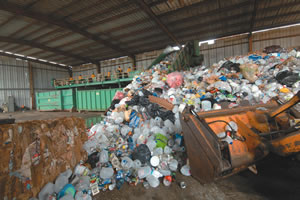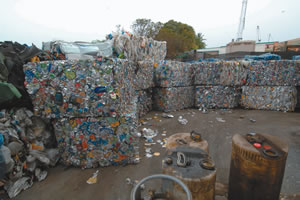What Happens When You Recycle
What happens to the stuff you recycle? To find out, MidWeek follows a bin from a local school to a sorting and packing center at Sand Island, and discovers that it’s a fascinating process people who frequent our local elementary schools with empty milk cartons, wine bottles and pickle jars as well as newspapers and cardboard boxes, it ends there, without wondering where the materials go from there.

|
breaking the still intact ones into smaller shards. “The mills don’t want it really fine,” Matuso explains. “I guess it’s easier for mills to sort it out, because they sort by color. So if it’s not fine and in larger pieces, they can find the colored pieces easier.
“This is only a small area (of bottles),” he laughs. I look at him dumbfounded. “Later I’ll show you the other glass area.”
Matsuo then takes us into another covered area he calls the “glob,” where the setup is similar to the paper and plastic compactor, except one large difference: a pile of HI-5 products higher than the glass materials we just saw. “This is about a day’s worth of work,” says Matsuo. “You’ll see why in a minute.”
Abulldozer operator pushes the mixture of HI-5 products onto a conveying system, which then go up to a second level where an assembly line of workers pull out trash and sort the materials, dropping them into the trash bin, a plastic bin, aluminum bin or letting them drop into the glass bin at the end of the line with a crash.

|
We walked up a set of metal stairs following the recyclables to the sorting floor, where about 10 people sporting gloves, masks and some with ear buds for music players reach out for and pull in certain products they’re looking for as the pile is transferred to their conveying belt. Like a well-oiled machine, they pick, pull and drop cans, bottles, trash and plastic into various bins. “Once the bins are full, we’ll bring it around and bail it,” Matsuo says. “We have to empty the glass bin every half hour. The trash bin we may have to empty every week.”
After watching in awe for a few minutes, Matsuo then escorted us to what has to be the prettiest part of the tour. Through a yard shared with a concrete company and behind a large fence sat several large mounds of what looked like coarse crystal sand, but is actually recycled glass.
The machine used to make the product is bigger than any other in the facility, towering over the shining mounds. Matsuo explains how the machine takes the broken glass we saw earlier and sifts it down into the soft substance before us.

|
He runs his hands through the finely produced glass, then shows us his uncut skin as the material sifts through his fingers. “Right now a construction company is taking about 2,000 tons of this to use as backfill. This is a very good product.” He mentions other uses for the materials, what he calls a “three-eighths product,” such as countertops or golf course sand.
“How much do you sell this for?” I ask. “We just give it away,” Matsuo says. He mentions the company wants to market the material.
This is the only product the facility makes that will stay on Oahu. The other materials end up in containers and are shipped out to the highest bidder. This time it’s China.
“We also ship to the Mainland a lot, or wherever. It just depends on where we can get the most for the materials,” says Greg Apa, the company’s vice president. “They don’t have forests to cut down (in China). We do. That’s the bottom line.”

|
Participating schools bring in between $600 and $2,700 a month, depending on how active they are in getting donations. This is about 50 to 60 percent of the cut the recycling business gets for the materials. “The schools get that majority of it,” he says.
With more than 100 recycling container bins distributed to the islands schools, Apa encourages people to continue to donate their materials to not only help the environment but also the help the schools. “The more we get in the containers, the more we reimburse the schools,” he says. “We would strongly encourage parents to help out at the schools to contribute more paper and mixed containers in there.”
Page 2 of 2 pages for this story < 1 2
E-mail this story | Print this page | Comments (0) | Archive | RSS
Most Recent Comment(s):








